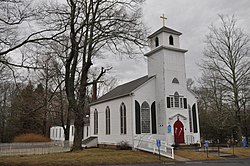
Union Village or "Bank Village" is a village and historic district located in North Smithfield and Woonsocket, Rhode Island on Rhode Island Route 146A. Union Village developed because it was at the cross roads of old Great Road and Pound Hill Road.
Millington is a village within the town of East Haddam, Connecticut. Millington lies halfway between East Haddam center and Salem center. It is the section of East Haddam that is the closest to Devil's Hopyard State Park. The village is connected to East Haddam Center and to Devil's Hopyard State Park by a series of secondary roads that are maintained by the state. The road is given an unsigned designation "Special Service Road 434", which runs on Mount Parnassus Road, Millington Road, Haywardville Road, and Hopyard Road.

The First Congregational Church of Plainfield is a historic Congregational church at 519 Norwich Road in Plainfield, Connecticut. It was built in 1816, for a congregation founded in 1705, to plans by noted early architect Ithiel Town, and is a relative rarity in the state as a Federal period stone church. The church was listed on the National Register of Historic Places in 1986. The congregation is affiliated with the United Church of Christ.
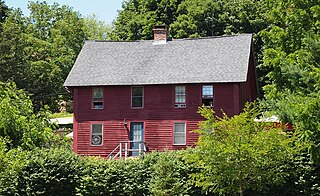
The Quaker Hill Historic District encompasses the center a mainly residential village in northeastern Waterford, Connecticut. Running in a mostly linear fashion along Old Norwich Road between Connecticut Route 32 and Richard Grove Road, the area first grew as a settlement of religious non-conformists in the 17th century, developed in the 19th century as a small industrial village, and became more suburban in character in the 20th century. Its architecture is reflective of these changes, and it was listed on the National Register of Historic Places in 2002.
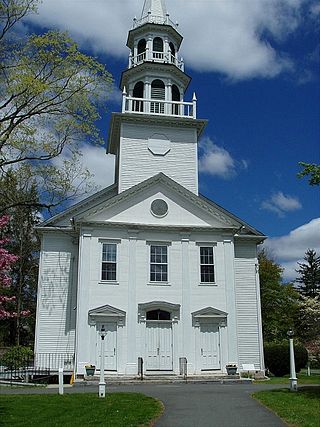
The South Britain Historic District encompasses the core of the unincorporated village of South Britain in Southbury, Connecticut, United States. The village arose in the 18th century as an industrial center serving the surrounding agricultural community, powered by the Pomperaug River, and rivalled the town center of Southbury in importance. The district was listed on the National Register of Historic Places in 1987.

The Huntington Center Historic District is a historic district in the city of Shelton, Connecticut. The district encompasses the original colonial settlement of Shelton, which was first known as Huntington. It is a linear district about 0.75 miles (1.21 km) in length, centered on the Huntington Green and Cemetery, and extending north along Church Street and south along Huntington Street. The district is predominantly residential, although it has two churches. The green was laid out in 1717, and many of the district's historic buildings were built over the next 150 years. The district's oldest building is a house with an estimated construction date of 1710. The district was listed on the National Register of Historic Places in 2000.
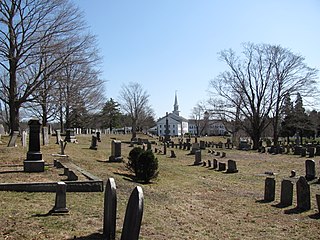
The Hanover Center Historic District encompasses the historic town center of Hanover, Massachusetts. Established in 1721, the town center includes the town hall, library, and church, as well as its first cemetery and the c. 1700 Stetson House, one of its oldest buildings. The district was listed on the National Register of Historic Places in 1996.

The Wendell Town Common Historic District encompasses the historic heart of the small town of Wendell, Massachusetts. Centered on a town common established in 1782, it includes a significant number of well preserved Greek Revival buildings. The district was listed on the National Register of Historic Places in 1992.

Norwichtown is a historic neighborhood in the city of Norwich, Connecticut. It is generally the area immediately north of the Yantic River between I-395 and Route 169.

Madison Green is the town green of the New England town of Madison, Connecticut. The green is the centerpiece of the Madison Green Historic District, and is located just west of the commercial strip of Madison on United States Route 1. The green is bounded on the south by US 1, Meeting House Lane on the east and north, and Copse Road on the west. Surrounding the green are several buildings, most prominent being the First Congregational Church. Other buildings around the green include Memorial Hall (1896), a community meeting building, Academy Elementary School (1884), and Lee Academy (1821), as well as many historic houses.

Bozrah Congregational Church and Parsonage is a historic church and parsonage at 17 and 23 Bozrah Street in Bozrah, Connecticut. The church, built in 1843, is a well-preserved example of churches transitional between Federal period meeting house architecture and 19th-century Greek Revival church architecture. The property was added to the National Register of Historic Places in 1991.

The Second Church of Christ, known more recently as the South Congregational Church, is a historic church in Hartford, Connecticut. Built in 1825–27, it is one of the oldest surviving public buildings in the city. It is the third home of its congregation, which was founded in 1670, and is one of the oldest purely Congregationalist groups in the nation. The building was listed on the National Register of Historic Places in 1978.

The Post Hill Historic District encompasses the oldest settled area of New London, Connecticut.

The New Preston Hill Historic District encompasses a small rural 19th-century village center in the New Preston area of the town of Washington, in Litchfield County, Connecticut. Settled in the late 18th century, it is distinctive for its examples of stone architecture, include a rare Federal period stone church. The district, located at the junction of New Preston Road with Gunn Hill and Findlay Roads, was listed on the National Register of Historic Places in 1985.
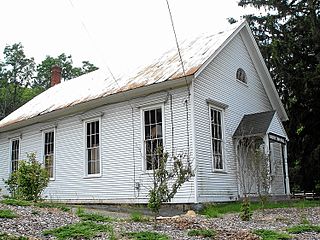
The Andover Center Historic District encompasses the historic town center of Andover, Connecticut. Centered on the junction of Hebron Road with Center Street and Cider Mill Road, the district includes houses dating to the town's early history, civic buildings including a library and former town hall, and the town's first cemetery. The district was listed on the National Register of Historic Places in 2003.
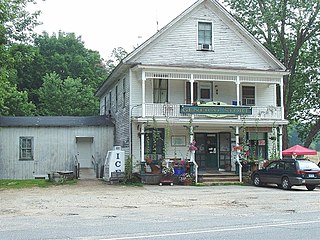
The Mansfield Center Historic District encompasses the historic early village center of Mansfield, Connecticut. First settled about 1692, it is one of the oldest settlements in Tolland County, and retains a strong sense of 18th century colonial layout. It extends along Storrs Street extending from Chaffeeville Road in the north to Centre Street in the south, and was listed on the National Register of Historic Places in 1972.

The First Congregational Church of Litchfield is a congregation of the United Church of Christ in Litchfield, Connecticut, USA, occupying a historic building on the Litchfield green.

Guilford Historic Town Center is a large historic district encompassing the entire town center of Guilford, Connecticut, in the United States. It is centered on the town green, laid out in 1639, and extends north to Interstate 95, south to Long Island Sound, west to the West River, and east to East Creek. It includes more than 600 historic structures, most built between the late 17th and early 20th centuries, reflecting the town's growth and history during that time. It was listed on the National Register of Historic Places in 1976.
The historical buildings and structures of Yarmouth, Maine, represent a variety of building styles and usages, largely based on its past as home to almost sixty mills over a period of roughly 250 years. These mills include that of grain, lumber, pulp and cotton. Additionally, almost three hundred vessels were launched by Yarmouth's shipyards in the century between 1790 and 1890, and the homes of master shipwrights and ship captains can still be found throughout the town.
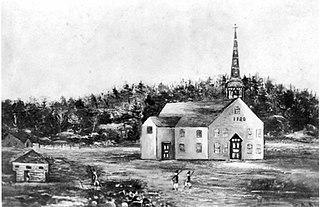
The Meetinghouse under the Ledge, also known as the Old Ledge Meetinghouse, was a church that stood in present-day Yarmouth, Maine, between 1729 and 1836. It was the ninth church founded in Maine.
